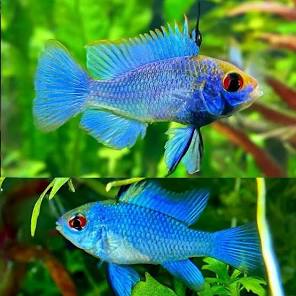1
/
of
1
Midwest Aquarium and Pond Supplier LLC
(130) Electric Blue Ram 1''
(130) Electric Blue Ram 1''
Regular price
$25.00 USD
Regular price
Sale price
$25.00 USD
Shipping calculated at checkout.
Quantity
Couldn't load pickup availability
The Electric Blue Ram (Mikrogeophagus ramirezi) is a selectively bred color variant of the standard ram cichlid, prized for its iridescent, neon-blue body. While a beautiful addition to a community tank, this variant can be more sensitive to water fluctuations than its wild-type relative, making it best suited for intermediate or advanced aquarists
Tank and water requirements
- Tank size: A minimum of 20 gallons is recommended for a pair, but a larger tank of 30 gallons or more is ideal for a community setting, as this offers more space and greater water stability.
- Substrate: Fine, soft sand is the best substrate. Rams are "eartheaters" that sift through the substrate for food, and coarse gravel can harm their sensitive gills.
- Filtration: Opt for a filter that provides excellent biological and mechanical filtration but avoids a strong current, as they prefer slow-moving water.
-
Water parameters:
- Temperature: Maintain a warm, stable temperature between 78–86°F (26–30°C). Stable temperature is critical, as sudden changes can stress the fish.
- pH: A slightly acidic to neutral pH is ideal, ranging from 6.0 to 7.5. Tank-raised specimens are more flexible, but stability is paramount.
- Water quality: They are very sensitive to poor water quality. Keep ammonia and nitrite at 0 ppm and nitrates below 20 ppm with weekly water changes.
- Decorations: Provide plenty of hiding spots and visual barriers with driftwood, caves (like clay pots), and dense live plants. Including floating plants can help dim the light, which they prefer.
Diet and feeding
Electric Blue Rams are omnivores and not typically picky eaters.
-
Food types: A varied diet is essential for vibrant colors and good health.
- Staple: High-quality carnivore pellets or flakes.
- Supplements: Include frozen or live foods, such as bloodworms, brine shrimp, and daphnia.
- Feeding schedule: Feed small amounts two to three times per day to encourage natural foraging behavior.
Temperament and tank mates
- Temperament: Generally peaceful, but males can become territorial, especially during spawning. A scarcity of hiding spots can lead to aggression.
-
Tank mates: Choose peaceful, non-aggressive species that can tolerate the same warm water. Suitable companions include:
- Small tetras (e.g., Neons, Cardinals, Rummy Nose)
- Corydoras catfish
- Rasboras
- Discus or angelfish
- Incompatible companions: Avoid keeping them with aggressive or fast-moving species that might outcompete them for food, as well as with other dwarf cichlids.
Share
No reviews

